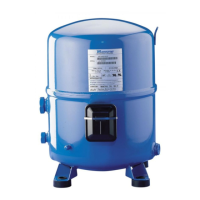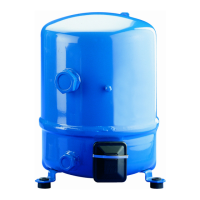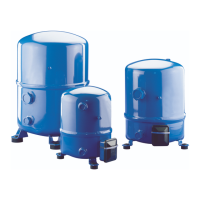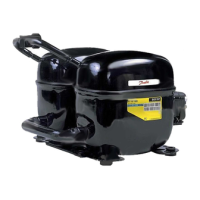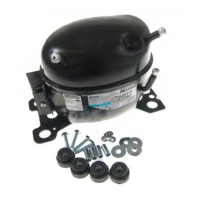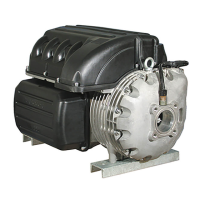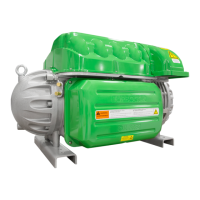25
INSTALLATION AND SERVICE
Leak detection
Whenever possible the compressor
must be kept isolated from the sys-
tem during leak detection by closing
the suction and discharge valves Use
a mixture of nitrogen and the nal re-
frigerant (eg. R404A or R507) and use
a leak detector for the applied refrig-
erant. A spectrometric detection sys-
tem using helium can also be applied.
Note that leak detection with refriger-
ant may not be allowed in some coun-
tries. Do not use other gasses such as
oxygen, dry air or acetylene as these
gasses can form an in ammable mix-
ture with the compressor oil. Never
use CFC or HCFC refrigerants for leak
detection of HFC systems. Leak detect-
ing additives shall not be used as they
may a ect the lubricant properties.
Warranty may be voided if leak detec-
tion additives have been used.
Eventual leaks shall be repaired
respecting the instructions written
above.
Vacuum pump-down and
dehydration procedure
Moisture obstructs proper operation
of the compressor and the rest of the
refrigeration system. Air and moisture
reduce service life, increase condens-
ing pressure and cause excessively
high discharge temperatures, which
are capable of destroying the lubri-
cating properties of the oil. Air and
moisture also increase the risk of acid
formation, thus giving rise to copper
plating. All these phenomena can ul-
timately induce mechanical and elec-
trical compressor failure. To eliminate
these risks, it is recommended to per-
form the following vacuum pull-down
procedure:
1. To the extent possible (i.e. if valves
are present), the compressor must be
kept isolated from the system.
2. After leak detection, the system
must be pulled-down under a vacuum
of 500 microns (0.67 mbar). A two-
stage vacuum pump shall be used
with a capacity appropriate for the sys-
tem volume. It is recommended to use
connection lines with a large diameter
and to connect these lines to the serv-
ice valves and not to the schrader con-
nection, so as to avoid excessive pres-
sure losses.
3. Once the vacuum level of 500 mi-
crons is reached, the system must be
isolated from the vacuum pump. Wait
30 minutes during which time the sys-
tem pressure should not rise. When
the pressure rapidly increases, the sys-
tem is not leak tight. Bring the system
pressure up to atmospheric pressure
with dry nitrogen or another suitable
inert gas in order to reform a new leak
detection. After repairing all leaks the
vacuum pull-down procedure should
be restarted from Step 1. When the
pressure slowly increases, this indi-
cates the presence of moisture. In this
case Steps 2 and 3 should be repeat-
ed.
4. Connect the compressor to the sys-
tem by means of opening the valves.
Repeat Steps 2 and 3.
5. Break the vacuum with either nitro-
gen or the ultimate refrigerant.
6. Repeat Steps 2 and 3 on the total
system.
Upon commissioning, the system
moisture content may be as high as
100 ppm. During compressor opera-
tion, the lter drier must reduce this
content to a level of 20 to 50 ppm.
Warning:
Do not use a megohmmeter or apply
power to the compressor while it is
under vacuum as this may cause mo-
tor winding damage, and never run
the compressor under vacuum as this
may cause the compressor motor to
burnout.
Refer to News bulletin "Vacuum pump
down and dehydration procedure" for
more complete information.
Start-up Before initial start-up or after a
prolonged shut-down period, energise
the crankcase heater 12 hours prior
to start-up. If the crankcase heater
cannot be energised long enough
before start-up, the compressor shall
be heated in another way (for example
with an electric heater or ood light)
to boil o refrigerant from the oil. This
is particulary important when ambient
temperature is low at commissioning.
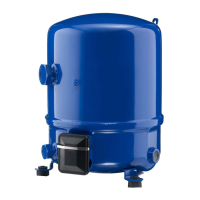
